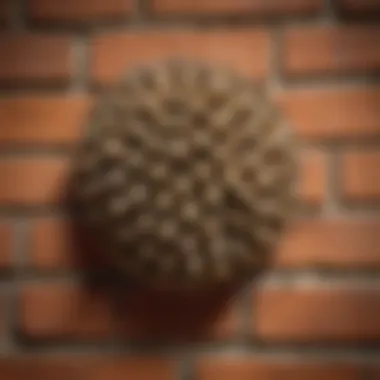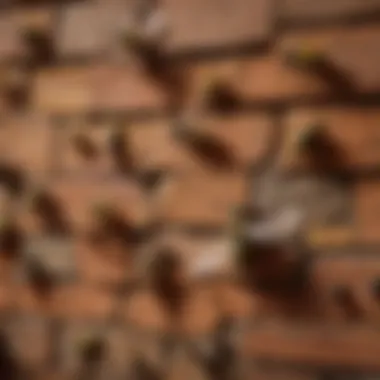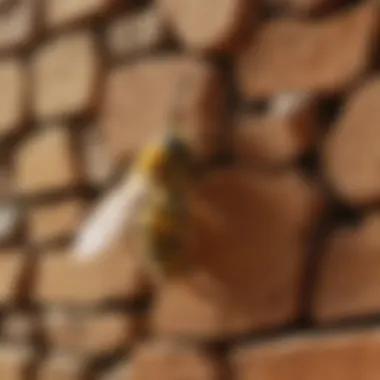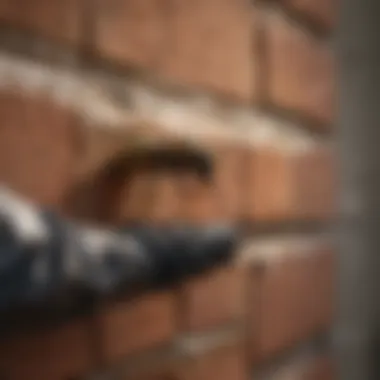Understanding Wasps in Brick Walls: Impact and Control


Intro
The presence of wasps in brick walls poses unique challenges for homeowners. Understanding the factors that lead to these nests is vital. Not only can wasps become a nuisance, but they can also inflict structural damage and create potential health risks. This guide aims to unravel the complexities surrounding wasps in brick walls, offering practical insights into identification, prevention, and treatment. The intention is to equip homeowners with the knowledge necessary to address these infestations effectively.
Pest Identification
Common Types of Wasps that Nest in Brick Walls
Wasps that commonly inhabit brick walls include the Yellow Jacket, Paper Wasp, and Bald-faced Hornet. Each possesses distinct characteristics that aid in their identification.
- Yellow Jackets are notable for their black and yellow markings. They often create nests in hidden areas, including wall cavities.
- Paper Wasps have a more slender body and are usually brown or tan. Their nests resemble upside-down umbrellas and can sometimes be found in cracks.
- Bald-faced Hornets are predominantly black with white markings. They build large, enclosed nests, often above ground, but can also be within walls.
Signs and Symptoms of Infestations
Identifying an infestation early is crucial. Here are common signs:
- Visible nests can sometimes be spotted during inspection. Look for small openings in the brickwork.
- Increased wasp activity around your home, especially in late summer and early fall.
- Noise from the interior wall can indicate an active nest.
- Dead wasps around the entry points are a strong indicator of nesting nearby.
It is essential to remain cautious, as wasps can become aggressive when threatened.
Prevention Strategies
Home Maintenance Tips for Pest Prevention
Preventing wasps from nesting is often more effective than dealing with an existing infestation. Consider the following:
- Seal Cracks and Holes: Inspect your brick walls for any potential entry points. Use caulk or expanding foam to seal these openings.
- Regular Maintenance: Keep gutters clear and repair any water damage that might create a habitat for wasps.
- Eliminate Food Sources: Store food securely. This includes pet food and trash, which can attract wasps.
"Preventive measures are often overlooked, yet they are the key to averting infestations."
Natural Deterrents and Barriers
Using natural repellents can be another effective approach. Some options include:
- Peppermint oil is known for repelling many pests.
- Vinegar traps can divert wasps away from your home.
- Ground cinnamon can deter wasps. Sprinkle it around areas where they are likely to nest.
Treatment Options
Overview of Chemical vs. Natural Treatments
When faced with an infestation, options divide into two categories: chemical and natural treatments.
- Chemical Treatments involve insecticides specifically designed to target wasps. They tend to be more immediate in effect but carry potential risks to people and pets.
- Natural Treatments often include traps or repellents that minimize harm to the environment. Though usually less effective, they are safer alternatives.
Step-by-Step Guides for DIY Treatments
For those who prefer a hands-on approach, here are steps to handle an infestation safely:
- Identify the Nest: Determine the location and type of wasp.
- Choose a Treatment: Select a method—chemical or natural, based on your safety preferences.
- Timing is Key: Treat in the evening when wasps are less active.
- Protect Yourself: Wear protective clothing to guard against stings.
- Follow-up: Check the nest over the next few days to ensure the treatment is effective.
Understanding and addressing wasps in brick walls can empower homeowners. Proper identification and timely action can reduce risks associated with these pests while ensuring the integrity of your home.
Prolusion to Wasps and Their Habitats
Understanding wasps and their habitats is key in managing their presence, particularly in and around brick walls. These insects contribute to our ecosystem, but they also pose risks when they invade human environments. Recognizing why and how wasps choose these locations helps homeowners take preventive actions.
Defining Wasps
Wasps are part of the order Hymenoptera, which also includes bees and ants. They are characterized usually by a slender body, with a narrow waist, wings, and distinct coloring that varies with species. Unlike bees, wasps have smooth stingers, allowing them to sting multiple times.
There are two main categories of wasps: solitary and social. Solitary wasps tend to build nests alone, while social wasps, such as yellowjackets and hornets, live in colonies and show complex behaviors. This distinction is important for effective pest management since social wasps are more likely to establish large nests in brick walls, leading to increased risks.
Common Species Associated with Nesting in Walls


Understanding the various species of wasps that may nest in brick walls aids in identification and control. Here are some common types:
Yellowjackets
Yellowjackets are highly social wasps known for their aggressive behavior. They are often recognized by their black and yellow coloration. They tend to build nests in the ground or in wall voids, making them common residents of brick structures. Their ability to forage for food, especially sugary substances, makes them a nuisance in both residential and commercial areas.
One key characteristic of yellowjackets is their nesting habits. They prefer to nest in sheltered locations like wall cavities. This leads to potential structural issues as they expand their nests, causing damage over time. Moreover, their aggressive nature can lead to serious stings, raising concern for homeowners.
Paper Wasps
Paper wasps are less aggressive compared to yellowjackets but still significant in urban areas. They are identifiable by their long legs and the construction of umbrella-shaped nests made of chewed wood fibers mixed with saliva. These nests often appear under the eaves of homes or in other sheltered spots.
Paper wasps might not cause direct harm to structures but can lead to problems when nests are built within wall spaces. Their presence can attract other pests, compounding issues related to brick wall integrity. Furthermore, they defend their nests when threatened, potentially causing health risks, especially for those with allergies.
Bald-Faced Hornets
Bald-faced hornets are a type of yellowjacket known for their distinctive white and black coloration. They build large, aerial nests that are often found in trees, but they sometimes nest near human structures. Their nesting habits can cause concern when nests are created in wall voids or similar spaces.
Their large nests can develop quickly, leading to significant control challenges. The aggressive nature of bald-faced hornets can pose health risks due to their potent stings. This aspect makes it crucial for residents to identify their presence early to mitigate threats effectively.
Why Wasps Choose Brick Walls
Understanding why wasps choose brick walls as nesting sites is crucial for homeowners. Wasps are often drawn to certain materials and structural features that provide them with advantages in terms of safety and environmental conditions.
Structural Advantages of Brick Walls
Brick walls offer a strong and secure structure for wasps to build their nests. Unlike less sturdy materials, brick can withstand various weather conditions, providing a stable environment. The durability of bricks protects nests from extreme heat and cold, ensuring that the larvae are safe as they develop. Additionally, the crevices and cavities in brick walls offer discrete locations for nesting, preventing easy access for predators. A strong wall also means less risk of structural damage, keeping wasps safe from disturbances that could collapse weaker materials.
Thermal Properties of Brick
Another reason wasps prefer brick walls is related to thermal properties. Brick has excellent insulating qualities. It tends to maintain a relatively consistent temperature, which is important for wasps, especially during colder months. This stability allows them to keep the nest warm enough for larvae to develop properly. The heat retention in brick is particularly advantageous during early spring when nighttime temperatures can drop but the wasps are still active and need suitable conditions for survival.
Access to Food Sources Nearby
Proximity to food sources influences wasp nesting behavior. Brick walls, often found in urban and residential areas, are near food sources such as garbage bins, gardens, and localized insect populations. Wasps are scavengers and benefit from these readily available resources. When there are constant food supplies nearby, the likelihood of established colonies growing greatly increases.
Identifying Wasps in Brick Walls
Identifying wasps in brick walls is crucial for both homeowners and pest control professionals. Wasps can pose serious risks, including structural damage and health concerns. Early detection can mitigate these issues and lead to effective control measures. Focusing on the key signs of infestation allows for a timely response. This section explores essential indicators of wasp presence. Understanding these signs can save property owners time and money.
Signs of Wasp Infestations
Nesting Materials
Nesting materials are one of the most telling signs of wasp infestations in brick walls. Wasps often use plant fibers, mud, or paper-like substances to construct their nests. These materials are lightweight yet sturdy, making them ideal for creating shelters within wall cavities. The ability of wasps to utilize readily available materials is a significant characteristic that makes their nesting behavior efficient.
Identifying these materials gives crucial insight into potential wasp activity. Recognizing nesting materials early can lead to effective management strategies before the infestation escalates. However, it is important to note that the presence of nesting materials does not automatically mean a large infestation. A small colony may produce minimal debris, while a large one may not display as much visible signs outside,
Live Insect Activity
Live insect activity is another clear indicator of a wasp infestation. Observing wasps flying in and out of openings in brick walls suggests that there is an active nest nearby. Their movements tend to become more pronounced during the late afternoon when they are busy foraging for food. The discernment of these patterns helps in identifying infestation stages and potential hotspots that need attention.
Noticing live insect activity helps assess the severity of the infestation. A high volume of activity indicates a larger population, which could necessitate more aggressive control measures. Understanding the dynamics of their behavior is a vital part of managing infestations effectively.
Physical Damage to Walls
Physical damage to walls can signal wasp presence. As wasps enter and leave through crevices or holes, they may inadvertently weaken the structure. Damaged areas may appear as chipped bricks or deteriorating mortar. This can compromise the overall integrity of a building, leading to costly repairs.
Recognizing the signs of damage early can facilitate prompt action. It may indicate a larger issue, as wasps tend to return to the same nesting site each year. Ignoring these signs can result in worsening conditions, making it essential to address any visible deterioration immediately.
Observation Techniques
Observation techniques play a pivotal role in identifying wasps in brick walls. Simple methods, like watching for insect activity and observing their entry points, are crucial. Homeowners should take time to inspect areas carefully. Paying close attention to potential nesting sites, especially during warmer months, allows pests to be acknowledged sooner. Visual spotting and understanding behaviors create pathways to effective control and prevention measures.
Potential Impacts of Wasp Presence


Understanding the impacts of wasps residing in brick walls is vital for homeowners. The presence of these pests may lead to significant structural, health, and safety concerns. Addressing these issues early helps ensure both peace of mind and the integrity of one’s property.
Structural Integrity Concerns
Wasps can pose notable threats to the structural integrity of brick walls. The nesting behavior of some wasp species can lead to various forms of damage. As they build their nests, they may create tunnels and cavities within the wall’s framework. Over time, this activity can lead to:
- Cracks in the walls: As nests grow and develop, they put pressure on the surrounding materials, leading to unsightly cracks.
- Water damage: Damaged walls may allow moisture to penetrate, leading to mold growth and rot.
- Insulation breakdown: Wall cavities may become less efficient in terms of insulation, leading to higher energy bills and uncomfortable living spaces.
Regular inspections are important to identify any signs of damage early. Homeowners should not overlook even small cracks, as they may lead to bigger problems in the future.
Allergy and Health Risks to Humans
The health implications of wasps are a significant concern. Stings from wasps can cause severe allergic reactions in susceptible individuals. Common reactions include swelling, pain, and redness, but for allergic individuals, impacts can be dire, including:
- Anaphylaxis: This is a severe, potentially life-threatening reaction that requires immediate medical attention.
- Increased anxiety: Even the presence of wasps can induce fear and anxiety in some homeowners, particularly those with past negative experiences.
- Infection risks: Stings that are scratched can lead to infections if not properly treated.
Homeowners should be vigilant about their environments. It is crucial to recognize the signs of wasp infestations not only for structural reasons but also for the safety and health of everyone living in the vicinity.
"Managing wasps effectively can significantly reduce both property damage and health risks, offering homeowners a secure and comfortable living space."
In summary, the impacts of wasps in brick walls extend beyond mere inconvenience; they can affect structural integrity and pose health risks. Thus, recognizing these potential challenges is key for proactive management.
Strategies for Prevention
Preventing wasp infestations in brick walls is crucial for maintaining a safe and healthy home environment. A proactive approach not only minimizes the risk of wasp presence but also protects the structural integrity of the home. Effective prevention strategies reduce the likelihood of significant damage and the associated health concerns, particularly if someone has allergies to wasp stings. Homeowners can take practical steps that serve to deter wasps from making a home in the walls.
Regular Inspections of Brick Walls
Regular inspections are key to early detection of wasp nests forming within brick walls. Homeowners should routinely check their property, focusing on areas that may be vulnerable to wasp colonization, such as gaps, cracks, and crevices. These are common entry points where wasps can establish their nests.
Identifying signs of wasp activity early can reduce potential damage. Look for:
- Nesting materials such as bits of paper or chewed wood.
- Increased insect activity around suspicious areas.
- Damage to brickwork, including chipped or crumbling walls.
Being vigilant with these inspections creates an opportunity to intervene before an infestation occurs, saving time and resources in the long run.
Sealing Potential Entry Points
Sealing potential entry points is an essential preventive measure against wasps nesting in brick walls. Gaps, cracks, and holes in the masonry can provide ideal shelters for wasps. Homeowners should inspect their brickwork and ensure that any openings are properly sealed. Products like caulk or expanding foam can be effective in filling these gaps.
In addition to sealing the exterior, it is also crucial to check vents and openings for wires or pipes. Using screens can provide an additional layer of protection against wasps entering these areas. By safeguarding these entry points, the chances of wasps infiltrating the brick walls significantly decrease.
Environmental Modifications
Making environmental modifications can effectively reduce the attractiveness of your home to wasps. By addressing factors that may draw them in, such as food sources or landscaping features, homeowners can make their property less appealing to these insects.
Eliminating Food Sources
Eliminating food sources is a vital step in wasp prevention. Wasps are attracted to areas with abundant food, especially from rot or sugary substances. By keeping outdoor areas clean and removing trash bins containing food waste, homeowners can mitigate wasp interest in their surroundings.
Key characteristics include:
- Regular trash disposal: Use tightly sealed bins and frequently remove waste.
- Minimizing spills: Clean up spills from fruits or other sugary materials promptly.
An attractive outdoor environment can lure wasps, so managing food sources is a beneficial choice in the article’s context. Preventing food access can lead to a significant reduction in wasp populations nearby, hence lessening the risk of infestations.
Managing Landscaping
Managing landscaping is another effective method of wasp prevention. The choice of plants and the layout of your garden can influence wasp activity. Certain plants can attract wasps and provide nesting opportunities.
Homeowners should consider:
- Choosing flowers wisely: Some flowers may be more attractive to wasps. Daisies and sunflowers are examples to be cautious with.
- Maintaining your garden: Overgrown areas can serve as habitats for insects, including wasps. Regularly trimming plants and using proper landscaping will discourage infestation.
Moving towards a garden concept that minimizes wasps can yield beneficial results. It helps to control their environment proactively, thus enhancing the appeal of your outdoor space while reducing infestation risks.


"Preventing wasp infestations requires a multi-faceted strategy that includes inspections, sealing entryways, and managing the environment."
By implementing these strategies for prevention, homeowners can protect themselves against the risks associated with wasp nests in brick walls.
Effective Control Methods
Controlling wasp populations is crucial for maintaining the safety and integrity of residential structures. Effective control methods help mitigate potential hazards posed by these insects. They can cause structural issues and health risks due to stings, especially for those with allergies. A comprehensive approach to control not only addresses current infestations but also reduces the likelihood of future problems.
Natural Deterrents
Natural deterrents serve as an eco-friendly alternative to chemical solutions. Many homeowners prefer this route due to environmental concerns and safety for pets and children. Common natural deterrents include essential oils such as peppermint, clove, and geranium. These oils create an unpleasant environment for wasps, often pushing them to seek shelter elsewhere.
To effectively use natural deterrents, dilution is important. Mixing essential oils with water can create a spray that can be applied near potential nesting sites. Although using natural options may not provide instantaneous results, they offer a safe method to dissuade wasps without harsh chemicals.
Chemical Treatments
Chemical treatments are often more potent and immediate, making them a widely preferred choice for more serious infestations. Their efficacy, however, comes with the responsibility of ensuring safety during application.
Applications in Nest Areas
Applying chemical treatments directly into nesting areas enhances their effectiveness. Products like pyrethroids are popular in these scenarios because they swiftly incapacitate wasps. For homeowners, this method allows precise targeting, decreasing the likelihood of wasps migrating to other areas.
The key characteristic of this approach is its rapid action. However, it is essential to follow the manufacturer's instructions closely. Misapplication can lead to unnecessary risks, including harm to beneficial insects or the environment.
Safety Precautions
When using chemical treatments, safety precautions cannot be overlooked. Proper protective gear should be worn during application, such as gloves and masks. This is especially important due to the potent nature of many chemical options available.
A unique feature of safe application practices is the timing of treatments. Applying these chemicals at dusk or dawn can minimize human exposure and reduce the risk of aggressive wasp behavior. While chemical treatments offer fast results, they require meticulous adherence to safety protocols to prevent unintended consequences.
Remember, the method chosen should reflect the severity of the infestation and the safety of all household members.
By understanding the available control methods, homeowners can effectively manage wasp populations in their brick walls, ensuring a safe and healthy living environment.
When to Seek Professional Assistance
Determining when to engage professional pest control services is crucial for effectively managing wasps in brick walls. Homeowners often underestimate the severity of an infestation, and this can lead to safety risks and further property damage. Engaging experts earlier rather than later can make a significant difference in resolving the issue efficiently and safely.
Assessing the Severity of Infestation
Assessing the severity of a wasp infestation involves several considerations. Homeowners should look for multiple signs, such as:
- Visible Nesting: If wasp nests are regularly observed, especially in hard-to-reach places within brick walls, this may indicate a more complex issue.
- Increased Activity: A noticeable rise in wasp activity around the home can suggest that nests are thriving, making intervention necessary.
- Physical Damage: Look for signs of damage to the wall structure, which might indicate an extensive infestation influencing the integrity of the building.
If several of these signs merge, it is wise to consult with pest control professionals. These experts can provide a thorough inspection and facilitate an accurate assessment, ensuring that no significant risks are overlooked.
Understanding Professional Pest Control Services
Understanding what professional pest control services offer can help homeowners make informed decisions. Typically, these services include:
- Comprehensive Inspections: Professional pest control agents thoroughly examine the property, checking for nests, entry points, and other conducive conditions for wasp habitation.
- Targeted Treatments: After assessing the situation, they implement targeted strategies to control the infestation safely. This may involve natural and chemical methods tailored to the specific needs of the situation.
- Follow-Up Services: Most professionals offer follow-up visits to ensure that the infestation is fully addressed and that new nests do not emerge.
While involving professionals may seem costly, it is often more efficient and effective than attempting DIY methods, which can sometimes exacerbate the problem.
The End
Understanding the dynamics of wasps nesting in brick walls holds significant importance for homeowners and pest management professionals. This article offers a comprehensive examination of the behavior, identification, and control methods concerning these insects. It does not only illuminate the structural and health risks associated with their presence but also provides actionable strategies to prevent infestations.
Recap of Main Points
In summary, several key points merit reiteration:
- Identification: Recognizing the signs of wasps in brick walls is crucial. This includes observing nesting materials, insect activity, and any physical damage.
- Impacts: These wasps can compromise the integrity of structures and present health hazards, particularly for those with allergies.
- Prevention Strategies: Regular inspections and sealing entry points can significantly reduce risks. Keeping environments clean and free from food sources is also important.
- Control Methods: Knowledge of natural deterrents and safe chemical treatments allows homeowners to tackle infestations effectively.
- Professional Help: Understanding when to seek professional services ensures that more severe infestations are managed properly.
These points serve as a solid foundation for managing wasp-related issues in brick walls, emphasizing the need for vigilance and proactive measures.
Final Thoughts on Management of Wasps in Brick Walls
The management of wasps nesting in brick walls involves a balanced approach between prevention and control. Homeowners must remain observant and proactive, not only addressing infestations as they arise but also anticipating potential issues before they develop. Taking preemptive steps such as regular inspections and environmental adjustments can create less hospitable conditions for wasps.
Considering both health risks and structural issues, the ability to identify and act against wasp activity is vital. Knowledge equips homeowners to maintain safer living spaces while preserving the integrity of their properties. Remember, being informed is the first step towards effective management, ensuring peace of mind in residential environments.



